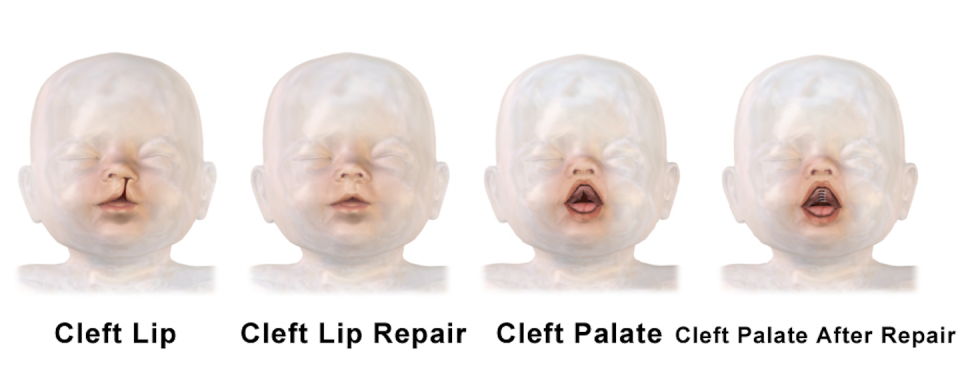Joaquin Phoenix’s lips are not like Napoleon's − here’s what everyone should know about cleft lip

Starring in the November 2023 film “Napoleon,” Joaquin Phoenix is back in the limelight, along with the prominent scar on his upper lip. You may recall in 2020, after discussing Phoenix’s appearance on her talk show, Wendy Williams received near universal condemnation for mocking those affected with cleft lip – a common birth defect in which the upper lip does not form completely while still an embryo. Note that it is also unclear whether Phoenix has a cleft lip or simply a scar. To her credit, Williams was quick to apologize. Regardless, this renewed attention to Phoenix’s scar offers another opportunity to highlight how people with facial differences (and their families) often feel stigmatized and can face discrimination and social isolation.
We have each devoted major portions of our professional lives to understanding what causes clefts and to the treatment and advocacy of those affected. We are geneticists and a pediatric craniomaxillofacial surgeon. The three of us felt this was an opportunity explain how clefts form and how clefts affect the people who live with them. And what, if anything, can be done to prevent them?
The ABCs of clefting
There are several different types of facial clefts. The most common are cleft lip, when the upper lip does not form properly, leaving a gap, and cleft palate, when the roof of the mouth does not close while a baby is developing in utero.
These birth defects arise very early during development when the embryo is about the size of a grain of rice. At this stage, the face is merely a collection of swellings rapidly growing toward one another in order to fuse together and form the lips, nose and palate. Thus, in a way, everyone starts out with clefts of the lip and palate.
In most cases, these swellings fuse before the end of the first trimester of pregnancy, forming an intact lip and palate. When this fails to happen, a child is born with a cleft of the lip, the palate or both. Worldwide, facial clefts are estimated to occur in 1 in 700 births, making it one of the most common birth defects.

How clefts harm quality of life
People with cleft lip and palate, as well as their families, face many issues associated with these birth defects. Although clefts may seem like cosmetic problems, they adversely affect basic functions like eating and speaking. Children with clefts must endure multiple corrective surgeries, often beginning when they are only a few months old. However, the surgeries are often just the beginning.
Many years of intensive orthodontic treatment and speech therapy are routinely needed. The total lifetime treatment cost is estimated to be at least US0,000 per individual. Beyond immediate medical care, individuals born with a cleft also tend to experience more learning difficulties, higher mortality rates at all stages of life and higher risk for other disorders, such as breast, brain and colon cancers.
Children born in the U.S. with these conditions are lucky to have these supports, given the myriad challenges cleft lips and palates present. There are superb teams dedicated to advocacy, to their care and support, and who work to address the needs of the children and their families.

Multiple factors cause clefts
Facial clefts have likely been around for as long as people have. An early example is the pharaoh Tutankhamun, better known as King Tut, who suffered from a partial cleft palate.
Because clefts are often externally visible features, many have tried to explain their occurrence. An early hypothesis suggested that the mother was pregnant during an eclipse, while Shakespeare attributed the feature to an intervention by mischievous sprites. Many cultures also believed that clefts were “in the blood,” or familial, which aligns with current understanding.
Our group at the University of Pittsburgh has spent many years trying to understand the causes of clefts, with some notable successes.
Clefts are considered “complex” by those who study birth defects, meaning that they result from a combination of environmental factors during pregnancy and family genetics. Some of the environmental causes include taking certain prescription medications and exposure to some toxins during pregnancy.
The completion of the Human Genome Project in the late 1990s and early 2000s provided important scientific tools for us to tease out the genetic factors leading to complex traits such as facial clefts. To date, scientists have identified at least 30 possible genetic regions increasing the risk of facial clefts, and we suspect that there are still many more regions to discover.
However, population-level studies such as the ones that identified those 30 genetic regions can tell us only so much. Researchers still face a major challenge identifying the specific genes that confer risk to specific individuals and families. There are other mysteries as well, such as why cleft palate alone is more common in girls, but when cleft palate is combined with cleft lip, it is more common in boys.
Are clefts preventable?
Parents who have a child with a cleft sometimes blame themselves. This is unfortunate, because there are still no known measures parents can take that will definitively prevent a facial cleft.
Doctors do know that smoking and poor nutrition during pregnancy can increase the chances of having a baby with a cleft. There is also some evidence that supplementation with folic acid before and during pregnancy may provide some protection.
As scientists learn more about the genetic and environmental risk factors for clefting, new actionable evidence will hopefully emerge that will bolster prevention efforts. Our most important task, however, is to work toward improving the quality of life for those affected. That starts with understanding.
This article was updated on Nov. 27, 2023 to note Joaquin Phoenix’s role in the film “Napoleon.”
This article is republished from The Conversation, a nonprofit, independent news organization bringing you facts and trustworthy analysis to help you make sense of our complex world.The Conversation has a variety of fascinating free newsletters.
It was written by: Mary L. Marazita, University of Pittsburgh; Bernard J. Costello MD, DMD, University of Pittsburgh, and Seth M. Weinberg, University of Pittsburgh.
Read more:
Adding folic acid to staple foods can prevent birth defects, but most countries don’t do it
Prenatal blood screening may predict Zika virus-associated fetal defects
Measles outbreaks show legal challenges of balancing personal rights and public good
Mary L. Marazita receives funding from the National Institutes of Health, primarily the National Institute of Dental and Craniofaical Research.
Bernard J Costello is affiliated with the AACMFS and ACPA. Past-president of the American Academy of Craniomaxillofacial Surgeons and Past-President of the American Cleft Palate-Craniofacial Association.
Seth M. Weinberg receives funding from the National Institutes of Health.

